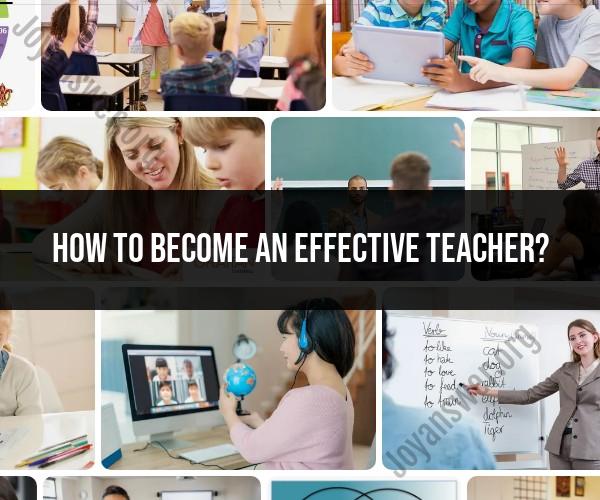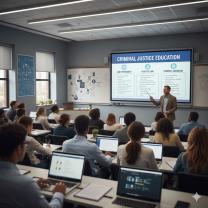How to become an effective teacher?
Becoming an effective teacher involves a combination of education, practical experience, and the development of key attributes and practices. Here are essential steps and characteristics to help you become an effective teacher:
Education and Training:
Earn a Teaching Degree:
- Obtain a bachelor's degree in education or a specific subject area, depending on the level and subject you wish to teach.
Complete Teacher Certification:
- Acquire the necessary teaching credentials or certifications required in your region.
Pursue Continuing Education:
- Stay informed about new teaching methodologies, technologies, and educational research through professional development courses and workshops.
Key Attributes:
Passion for Teaching:
- Develop a genuine passion for education and a sincere desire to help students succeed.
Patience:
- Cultivate patience and understanding, recognizing that students learn at different paces and in different ways.
Flexibility:
- Be adaptable and willing to adjust your teaching methods based on the needs of individual students or changes in the learning environment.
Empathy:
- Understand and empathize with the diverse backgrounds, experiences, and challenges of your students.
Effective Communication:
- Communicate clearly and effectively, both verbally and in writing, to ensure that students comprehend the subject matter.
Positive Attitude:
- Maintain a positive and encouraging demeanor to create a supportive and motivating learning environment.
Classroom Management:
Establish Clear Expectations:
- Set clear expectations for behavior and academic performance from the beginning of the school year.
Consistent Discipline:
- Enforce rules consistently and fairly to create a structured and respectful classroom environment.
Effective Time Management:
- Manage classroom time efficiently, balancing instructional time with activities and transitions.
Classroom Organization:
- Keep the classroom organized and conducive to learning, with clear pathways and a visually engaging environment.
Student Engagement:
Interactive Teaching Methods:
- Incorporate diverse and interactive teaching methods, such as group activities, discussions, and hands-on projects.
Use of Technology:
- Integrate technology tools and resources to enhance learning experiences and engage students in the digital age.
Differentiated Instruction:
- Tailor your teaching approach to accommodate diverse learning styles and abilities within the classroom.
Continuous Reflection and Improvement:
Self-Reflection:
- Regularly reflect on your teaching practices, seeking ways to improve and refine your methods.
Professional Development:
- Attend conferences, workshops, and training sessions to stay informed about current educational trends and best practices.
Seek Feedback:
- Welcome feedback from students, colleagues, and administrators to gain insights into your teaching effectiveness.
Adaptability to Change:
- Embrace change and be open to adopting new strategies and techniques that enhance student learning.
Building Positive Relationships:
Student-Teacher Relationships:
- Build positive, respectful, and supportive relationships with your students, fostering a sense of trust and connection.
Parental Involvement:
- Communicate regularly with parents or guardians, involving them in their child's education and addressing any concerns promptly.
Collaboration with Colleagues:
- Collaborate with fellow teachers and staff members to share ideas, resources, and support each other's professional growth.
Lifelong Learning:
Stay Informed:
- Stay informed about educational trends, research, and policies to remain a knowledgeable and effective educator.
Adaptability:
- Embrace a growth mindset and be willing to adapt to changes in the educational landscape.
Remember that becoming an effective teacher is a continual process of growth and development. Each classroom and group of students is unique, so the ability to adapt and refine your teaching strategies is crucial to fostering a positive and productive learning environment.
What strategies and paths lead to becoming an effective teacher?
Strategies and Paths to Becoming an Effective Teacher:
Becoming an effective teacher requires dedication, continuous learning, and the development of a diverse set of skills and knowledge. Here are some key strategies and paths to follow:
1. Cultivate Passion and Commitment:
- Develop a genuine passion for teaching and learning.
- Embrace the challenge of nurturing young minds and inspiring students to reach their full potential.
- Demonstrate a commitment to continuous self-improvement and growth in the field of education.
2. Develop Strong Foundational Knowledge:
- Master the subject matter you intend to teach.
- Stay updated with current research, trends, and pedagogical practices in your field.
- Continuously seek opportunities to expand your knowledge base and broaden your understanding of your chosen subject.
3. Master Effective Pedagogical Skills:
- Develop a diverse repertoire of teaching methods and strategies to cater to different learning styles and needs.
- Learn to effectively plan engaging and well-structured lessons.
- Master classroom management skills to create a positive and supportive learning environment.
- Foster critical thinking skills in students and encourage active learning and participation.
4. Build Strong Relationships with Students:
- Get to know your students individually, understanding their strengths, challenges, and learning styles.
- Build trust and rapport with your students, creating a safe and inclusive classroom environment.
- Communicate effectively with students, providing clear instructions and constructive feedback.
- Foster a sense of belonging and community within your classroom.
5. Embrace Technology and Innovation:
- Integrate technology effectively into your teaching practice to enhance learning experiences.
- Explore and utilize various online resources and tools to supplement your curriculum and engage students.
- Stay informed about emerging technologies and their potential in education.
6. Collaborate and Reflect:
- Actively seek opportunities to collaborate with colleagues and share best practices.
- Observe other effective teachers and learn from their experiences.
- Engage in regular self-reflection and analysis of your teaching practices.
- Seek constructive feedback from mentors, peers, and students to identify areas for improvement.
7. Pursue Professional Development Opportunities:
- Attend professional development workshops and conferences to enhance your knowledge and skills.
- Participate in online courses and training programs to learn new teaching strategies and methodologies.
- Network with other educators and join professional organizations to connect with peers and share resources.
8. Develop Adaptability and Resilience:
- Understand that every teaching experience is unique and requires flexibility.
- Learn to adapt your teaching methods to different situations and unexpected challenges.
- Develop resilience and perseverance to overcome obstacles and setbacks.
9. Practice Mindfulness and Self-Care:
- Prioritize your mental and physical well-being to avoid burnout.
- Develop healthy coping mechanisms to manage stress and maintain a positive attitude.
- Practice mindfulness and self-care to maintain a sense of balance and well-being.
10. Embrace Lifelong Learning:
- Recognize that teaching is a lifelong journey of learning and growth.
- Remain curious and open to new ideas and perspectives.
- Continue to learn and evolve throughout your career, seeking continuous improvement and growth.
Remember, there is no single path to becoming an effective teacher. The most important aspect is to embrace the journey, commit to continuous learning and improvement, and consistently strive to create a positive learning environment where all students can thrive.
Additional Resources:
- National Board for Professional Teaching Standards (NBPTS): https://www.nbpts.org/: https://www.nbpts.org/
- National Education Association (NEA): https://www.nea.org/: https://www.nea.org/
- American Federation of Teachers (AFT): https://www.aft.org/: https://www.aft.org/
- Khan Academy: https://www.khanacademy.org/: https://www.khanacademy.org/












